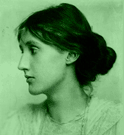




Virginia (Stephen)
Woolf was a British novelist, feminist essayist, critic, and leading writer of
modernism. She was born as Adeline Virginia Stephen on January 25, 1882 to the
parents of Leslie Stephen and Julia Duckworth. She was educated by her father
at home. Virginia Woolf suffered bouts of bipolar disorder beginning after the
death of her mother in 1895 when Woolf was just a teenager (the first of many
deaths Virginia Woolf would experience throughout her life). Woolf’s
half-sister, Stella, filled the motherly role after Julia’s (her mother’s)
death, but died a mere two years later. Leslie Stephen (her father) suffered
from a long struggle with cancer and finally died in 1904. After his death,
Virginia, her sister Vanessa, and her two brothers, Adrian and Toby moved to a
house in Bloomsbury. This house became the center of a literary group known as
the Bloomsbury Group that met at frequent intervals for over thirty years;
Virginia Woolf was a critical center to this group. Toby Steven died in 1906,
two years after the siblings moved to Bloomsbury; with this Virginia Woolf once
again entered a state of mental instability. In 1912, Virginia married a writer
named Leonard Woolf and moved with him to Clifford’s Inn. In 1913, Virginia
Woolf attempted her first suicide, but failed. In 1917, the Woolfs’ founded
Hogarth Press, a publishing house that printed many works of famous authors.
Hogarth Press would later publish all of Virginia Woolf’s works, with one
exception: her first novel (named “The Voyage Out,” which was published in
1915). Soon after this book had been published, she had suffered from another
depression. Virginia Woolf, on March 28, 1941, during what would be her final
bout of depression, filled her pockets with stones and drowned herself in the
Ouse River. She left a note for her husband saying that she was afraid she had
gone mad and could not recover.
Many parallels can be drawn between Virginia Woolf’s life and her characters in
her novel, “To the Lighthouse.” Mr. and Mrs. Ramsey, the parental units in this
novel, are loosely modeled after Virginia’s own parents with conflicting views
between genders. “To the Lighthouse” is set in the upper middle class
background - a background Virginia herself was from and very familiar with.
Finally in “To the Lighthouse,” many family members died and left others close
to them feeling the pain.
Other Works By Virginia Woolf
The Voyage Out (1915)
Night and Day (1919)
The Mark on the Wall
(1921)
Jacob’s Room (1922)
Mrs. Dalloway (1925)
The Common Reader (1925)
The Common Reader: Second Series (1932)
To the Lighthouse
(1927)
Orlando(1928)
A Room of One’s Own (1929)
The Waves (1931)
Three Guineas (1938)
Between the Acts (1941)

Introduction
Author Background
Setting
Plot
Characters
Figurative
Language
Diction/
Syntax
Tone
Themes/
Motifs
Memorable
Quotes
Meet
the Designers
Helpful_Hints
Home
